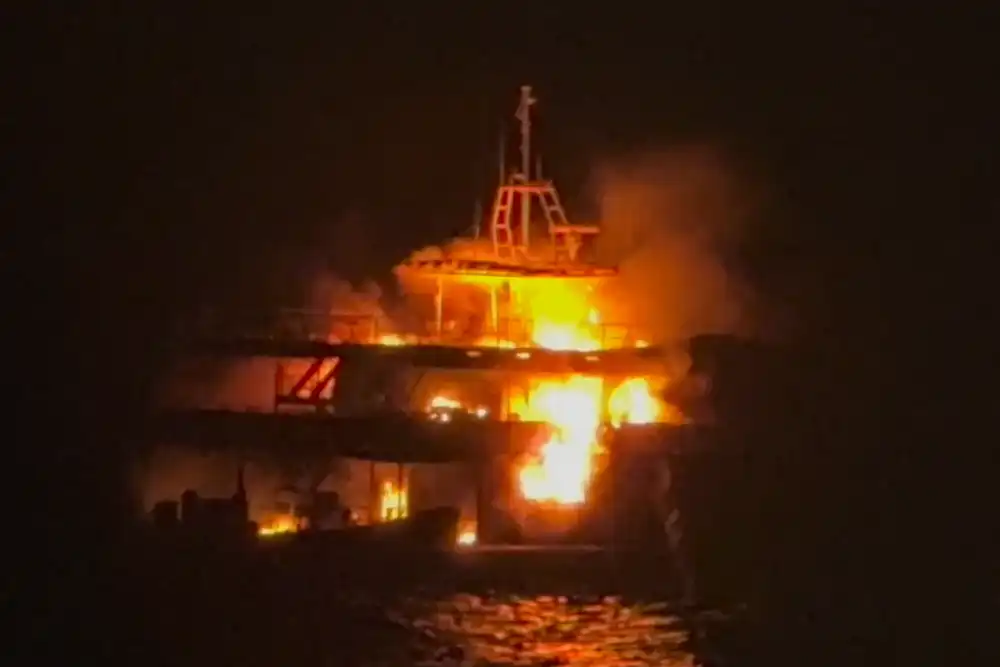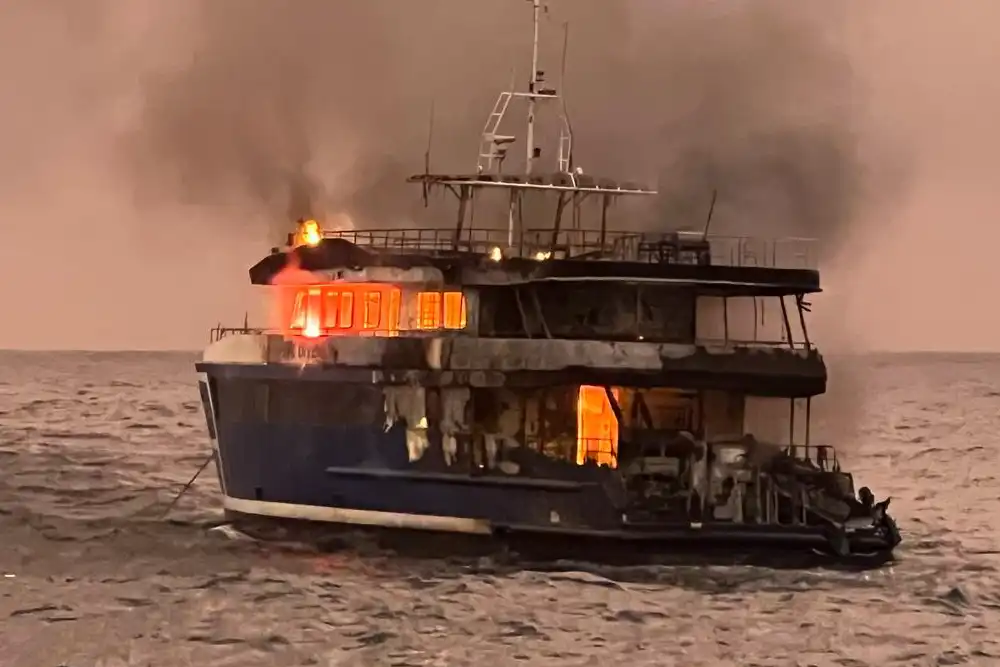
On 12 April 2025, the Thai liveaboard DiveRACE Class E caught fire on the final night of a Similan Islands cruise. Everyone survived, but they were not unscathed, and the fire has brought liveaboard safety failings into question yet again. DIVE spoke to some of the survivors.
This article was split in two due to its length. Part 2 is here.
In the early hours of 12 April 2025, the Thailand-based luxury liveaboard Dive Race Class E caught fire on the final night of a five-day cruise through the Similan Islands.
All 16 passengers and ten crew survived, but the incident has not been reported in the global media with the same intensity of scrutiny that followed the Sea Story disaster of November 2024, in which eleven people died when their Egyptian Red Sea liveaboard capsized.
While the Class E fire survivors escaped without serious physical injury, the incident has taken a heavy toll on the mental health of those who escaped the inferno, and they are very aware that the litany of safety failures leading up to their rescue could have made their situation far, far worse.
No muster drill

Nicole Yeates, who works for the US Department of the Navy, and her husband Joe, a serving US Navy Officer, were on a three-week, first-class ‘trip-of-a-lifetime’ to Thailand before Joe headed out to sea for an extended period of duty.
Nicole, a self-confessed ‘big trip planner’ who enjoys researching the minutia of a potential holiday, did plenty of investigation before settling on DiveRACE Class E (from hereon just Class E), a well-appointed 34.5-metre steel-hulled vessel launched in 2015 that came with an excellent safety record and brilliant reviews.
The couple was picked up in the afternoon of 8 April and boarded Class E in the evening with another 14 divers. They set sail soon after arriving, and while the lead guide presented a safety briefing in the saloon, there was no proper muster drill to familiarise the guests with the boat’s emergency equipment and procedures.
‘We got there in the evening of 8 April and got underway,’ Nicole said. ‘There was no safety briefing other than a kind of, “here’s this, there’s that”, you know?
‘They said our life jackets are in the state rooms and the life rafts are on the top deck but there was no drill of any kind.’
Chanhyeok ‘Chris’ Kim, a diver from South Korea enjoying his first liveaboard – and who is also chief officer for a 200,000MT merchant ship – told the same story
‘The lead divemaster gave a short briefing about safety instructions,’ said Chris, ‘however, it was just: life jacket is in your cabin; life raft is on top.
‘They didn’t tell us about other safety equipment, for example, the place of the fire extinguisher or the fire alert system. Also, they didn’t talk about the muster station for fires or the abandon ship situation.’
No smoke detectors or fire alarm

For most of the voyage, everything was almost perfect, and Nicole gives praise to the crew where it’s due. ‘Things were efficient,’ she says; ‘they were well run and everything was well organised. The food was excellent and, overall, it was really well done – no complaints.’
On the last night of the trip, Class E and her passengers were moored over the Boonsong wreck when it became apparent that the vessel they were on was anything but perfect.
‘At about 3.15, 3.20 in the morning, Joe wakes me up and he tells me: “get up”,’ says Nicole. ‘He said: “Do you smell that smoke?”, but I’m half asleep at this point so I kind of take it with a grain of salt.
‘And then I hear somebody yelling, “Evacuate! Evacuate!”’
There were no smoke detectors or fire alarm system on board, and no roving night watch posted by the crew. The alarm was raised by a passenger who, unable to sleep, had been up on deck at the time the fire broke out.
Nicole and her husband left their cabin to investigate, and the nature of the emergency was instantly apparent.
‘As soon as we got into the hallway, there was thick smoke,’ said Nicole. ‘I tried to cover my mouth, but it was too much, and very acrid, so we ducked down and went outside onto the dive deck.
‘The smoke was out there too. We went to the edges to try and get some fresh air but it was already overwhelming the dive deck.’
They did not see any flames at this point, only smoke, so the couple headed out to the dining area on the upper deck, where other passengers were starting to gather.
‘We had about half the passengers at that point,’ said Nicole. ‘The head divemaster and a couple of the other divemasters showed up but then smoke started filling that area too, and it got too rough, so we walked along the side and went up to the front of the boat.’
Not realising the gravity of the situation, none of the assembled passengers had brought their life jackets with them.
‘It all happened too fast,’ said Nicole, ‘and I don’t think anybody realised that when people said “it’s smoky” that they were going to be jumping over the side.’
A couple of the female crew members, apparently unable to swim, had turned up with life rings.
No power, no radio, no battery backup

Approximately 10 minutes after leaving their cabins, the passengers realised the whole boat was without power – and had been for some time.
Another liveaboard, the MV Raga, owned by Smile Dolphin Adventures, was moored nearby but there did not seem to be any attempt by the crew to make contact.
According to Chris – who is in charge of his merchant ship’s firefighting team – Class E’s captain was at the front of the boat, and did not appear to be in control of the situation.
‘He could not speak English and looked panicked,’ he said, ‘so I went to the bridge to use the distress signal.
‘I tried to call by VHF radio, but it was not working because there was no electricity, so I tried to push the distress button, but it was also not working.
‘I tried to find other emergency equipment, but there was nothing,’ Chris continued. ‘The only thing I found was SART [Search and Rescue Transponder, which can be detected by other ships’ radar] but it was not that important in this situation.
‘So I couldn’t do anything because there was no power, and the batteries were also not working.’
DIVE has spoken with the DiveRACE Class E’s Singapore-based owner, who said in a written statement that ‘independent back-up batteries, radios and fire extinguishers were available’.
The simple facts remain, however, that two highly trained maritime officers – one civilian and one military – could not find a working radio on the bridge and, if there was a backup on board, neither the captain nor any of his crew put it to use.
‘The is pretty key to me,’ says Nicole, ‘and very aggravating. They went to the bridge to look for the bridge-to-bridge radio, assuming it had a battery backup. It did not.
‘They went looking for an emergency beacon. No battery backup on that, either, so no way to signal Mayday. Nothing.’
SOS by smartphone

With no way to communicate with the outside world, people started to signal Raga using the flashlights on their mobile phones.
‘They were probably 150 to 200 metres away,’ said Nicole, ‘far enough to circle the anchor chain and not hit us. People were trying to signal SOS with the flashlights on their phones, but [the crew of the other boat] also seemed to be sleeping, and there was nobody on the bridge because we couldn’t get their attention.’
By this time the fire had taken hold on the back deck. Unable to raise a reaction from the other boat, and with no way to signal an emergency, the passengers realised they were probably going to have to abandon ship.
‘At this point we could see a glow in the back of the boat, and it was getting worse and worse,’ says Nicole. We are talking via a video call, and it is clear to see the memory is clearly not easy for her.
‘We heard planks starting to hit the dive deck, and we start hearing air hoses start popping, which is just feeding the fire, and we heard things exploding.’
Somebody was bringing life jackets up to the forward deck, so Nicole and her husband – both strong swimmers and, as US Navy personnel, able to handle emergencies pretty calmly – start passing them out.
Sea conditions worsened as the boat burned – Nicole estimates a 1.5–1.8 metre swell – and a steady drizzle made the decking slippery, causing her to fall and break her sacrum (the triangular bone situated between the two hip bones of the pelvis) as she was helping.
It also became clear at while they were preparing to abandon ship that two divers were missing. Fortunately, one of the divemasters – a foreign national, not a member of the Thai crew – was able to open the forward emergency hatch, enabling them to escape the lower deck.
The liferafts were deployed – again, not by the crew but by one of the foreign divemasters and a passenger. Sea conditions and current made them difficult to access when people started jumping into the water, but – very importantly – they remained tethered to the vessel while the passengers abandoned ship, rather than drifting away, useless, into the dark.
By this time, the flames and the noise of the small explosions had aroused the attention of Raga’s crew, who deployed their boat’s tenders and weighed anchor to pick up Class E’s survivors.
The first mayday was issued by Raga’s captain at approximately 4.15 am.
This story, for reasons of length, appears in two parts. The second part is available here.
Related articles
- Fire Alert – Improving liveaboard fire safety for divers
- Liveaboard safety – how divers can change it and when to walk away
- Emperor Seven Seas liveaboard destroyed by fire in Port Ghalib
- Sea Story liveaboard survivor tells her story
- Divers rescued after Komodo liveaboard sinks
- Generations Below – a father-son team working to build a global underwater treasure hunt - 11 November 2025
- ‘Death ball’ sponge among 30 new Ocean Census species discoveries - 10 November 2025
- Thomas Kenny’s family launches fundraiser for inquest into his death - 7 November 2025


